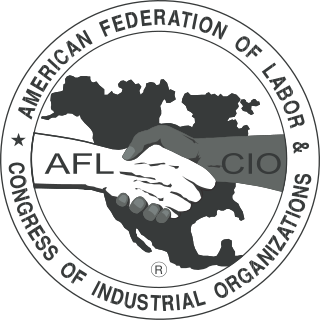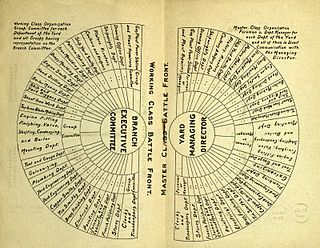Related Research Articles

The American Federation of Labor and Congress of Industrial Organizations (AFL–CIO) is the largest federation of unions in the United States. It is made up of 56 national and international unions, together representing more than 12 million active and retired workers. The AFL–CIO engages in substantial political spending and activism, typically in support of liberal or progressive policies.

Industrial unionism is a trade union organizing method through which all workers in the same industry are organized into the same union—regardless of skill or trade—thus giving workers in one industry, or in all industries, more leverage in bargaining and in strike situations.

The American Federation of Labor (AFL) was a national federation of labor unions in the United States founded in Columbus, Ohio, in December 1886 by an alliance of craft unions disaffected from the Knights of Labor, a national labor union. Samuel Gompers was elected the full-time president at its founding convention and reelected every year, except one, until his death in 1924. He became the major spokesperson for the union movement.
The labor history of the United States describes the history of organized labor, US labor law, and more general history of working people, in the United States. Beginning in the 1930s, unions became important allies of the Democratic Party.

John Joseph Sweeney was an American labor leader who served as president of the AFL-CIO from 1995 to 2009.
Craft unionism refers to a model of trade unionism in which workers are organised based on the particular craft or trade in which they work. It contrasts with industrial unionism, in which all workers in the same industry are organized into the same union, regardless of differences in skill.
Amalgamated Clothing Workers of America (ACWA) was a United States labor union known for its support for "social unionism" and progressive political causes. Led by Sidney Hillman for its first thirty years, it helped found the Congress of Industrial Organizations. It merged with the Textile Workers Union of America (TWUA) in 1976 to form the Amalgamated Clothing and Textile Workers Union (ACTWU), which merged with the International Ladies' Garment Workers' Union in 1995 to create the Union of Needletrades, Industrial and Textile Employees (UNITE). UNITE merged in 2004 with the Hotel Employees and Restaurant Employees Union (HERE) in 2004 to create a new union known as UNITE HERE. After a bitter internal dispute in 2009, the majority of the UNITE side of the union, along with some of the disgruntled HERE locals left UNITE HERE, and formed a new union named Workers United, led by former UNITE president Bruce Raynor.

The United Brotherhood of Carpenters and Joiners of America often simply, the United Brotherhood of Carpenters (UBC) was formed in 1881 by Peter J. McGuire and Gustav Luebkert. It has become one of the largest trade unions in the United States, and through chapters, and locals, there is international cooperation that poises the brotherhood for a global role. For example, the North American Chapter has over 520,000 members throughout the continent.

The Strategic Organizing Center (SOC), formerly known as the Change to Win Federation (CtW) is a coalition of North American labor unions originally formed in 2005 as an alternative to the AFL-CIO. The coalition is associated with strong advocacy of the organizing model. The coalition currently consists of The International Brotherhood of Teamsters (IBT); Service Employees International Union (SEIU); and United Farm Workers (UFW). Communications Workers of America (CWA) is affiliated with both the SOC and AFL-CIO.
A Directly Affiliated Local Union (DALU) or federal labor union is a U.S. labor union that belongs to the AFL-CIO but is not a national union and is not entitled to the same rights and privileges within the Federation as national affiliates.

The Oil, Chemical and Atomic Workers Union (OCAW) was a trade union in the United States which existed between 1917 and 1999. At the time of its dissolution and merger, the International represented 80,000 workers and was affiliated with the AFL–CIO.
Dual unionism is the development of a union or political organization parallel to and within an existing labor union. In some cases, the term may refer to the situation where two unions claim the right to organize the same workers.

The Department for Professional Employees, AFL–CIO (DPE) is a semi-autonomous "trade" department of the AFL-CIO, and serves as an advocate for professional workers within the federation, and before legislative bodies, the press and the public.
The Scranton Declaration, sometimes called the Autonomy Declaration, was passed in 1901 by the American Federation of Labor (AFL) and made craft autonomy, or craft unionism, the cornerstone of the organization. Craft unionism meant that unions were formed on the basis of the trade practiced by a group of skilled workers, in contrast to industrial unionism.
An independent unions is a trade union that represents workers in one plant or company and is free of employer control.. In North America, a national independent union is a union of a national character not affiliated with the AFL or CIO; a local independent union is one of a local character not affiliated with the international union having jurisdiction over that branch of industry.
The Pennsylvania AFL–CIO is a federation of labor unions in the U.S. state of Pennsylvania in the United States. It is an affiliate of the AFL-CIO. It was formed on June 9, 1960, by the merger of two predecessor bodies, the Pennsylvania Federation of Labor and the Pennsylvania Industrial Union Council. It can trace its history through its predecessor bodies to 1890.

North America's Building Trades Unions (NABTU) is a labor federation of 14 North American unions in the building trade, founded by the American Federation of Labor in 1907.
The Mechanics Educational Society of America (MESA) was an independent trade union of tool-and-die-makers. First active in the automobile industry of greater Detroit, Michigan, MESA was founded in 1933 and was "the first union to effectively establish itself in what had been a traditionally open shop strong, Detroit's mass production automobile industry." MESA's general secretary was English immigrant Matthew Smith.
References
- ↑ Klemm, Mary (1944). "The Rise of Independent Unionism and the Decline of Labor Oligopoly". The American Economic Review. 34 (1): 76–86. ISSN 0002-8282.
- Council Bluffs [Iowa] Nonpareil, July 25, 1946, p. 2
- Taft, Philip (Apr 1956). "Independent Unions and the Merger". Industrial and Labor Relations Review. 9 (3, The AFL–CIO Merger): 433–446. doi:10.1177/001979395600900309. JSTOR 2519880.
- TIME magazine, March 10, 1958 obituary of Matthew Smith, secretary of the Mechanics Educational Society of America
- Troy, Leo (Apr 1961). "Local Independent Unions and the American Labor Movement". Industrial and Labor Relations Review. 14 (3): 331–349. doi:10.1177/001979396101400301. JSTOR 2519458.
- Mergen, Bernard (Apr 1972). "Blacksmiths and Welders: Identity and Phenomenal Change". Industrial and Labor Relations Review. 25 (3): 354–362. doi:10.1177/001979397202500303. JSTOR 2521318.